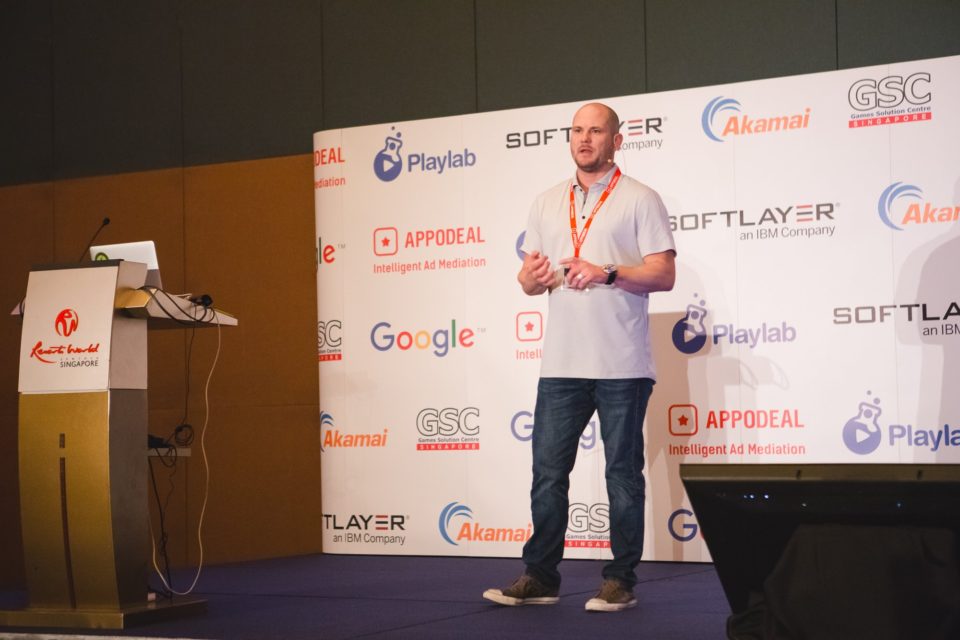They installed your app…now what? At Casual Connect Asia Ian Atkinson from AdColony explained what! “70% of players like rewarded ads, so it’s leaving money on the table to not do it!”, Ian pointed out during this solo session, explaining how the top mobile app publishers are engaging and retaining users longer while maximizing monetization and minimizing SDK bloat.

DOWNLOAD SLIDES

Ian Atkinson is vice president of business development at AdColony, responsible for partnering with game publishers and tech vendors. The goal is to assist them by enhancing monetization and, at the same time, to deliver high quality inventory for advertisers on the AdColony network. Ian brings to this work more than 20 years of experience in both startups and large game publishers, with particular expertise in the digital and interactive entertainment markets.
Recently, Ian discussed the work they do with Casual Connect and shared essential insights into the challenges of monetization, especially in a game culture where users expect to play games for free.
Casual Connect: Tell us about the work you do at AdColony. How did you come to work there?
Ian Atkinson: I am head of business development for the Games Publishing group at AdColony. My main responsibilities are to bring new publishers and developers to the AdColony mobile video platform as well as work with our product team to bring new and innovative products and services to the market. I joined AdColony after working for two gaming startups, Playnomics and Sleepy Giant (later adaptiv.io).
CC: What is your favorite thing about your job?

Ian: I love working with publishers and developers to help them see financial success from their hard work. For me, this involves deep dives into their games to understand the game mechanics, economy and core activity loops so that I can recommend the best way to use mobile video products. I love interacting with the passion and creativity involved to make, launch and run games.
CC: How have your past experiences been helpful to you in your work at AdColony?
Ian: I’ve had several phases in my career that help me with my current role. My days as a management consultant implementing e-commerce systems gave me perspective on how to design and drive in-app purchases. My life as a technology investment banker helps me structure win-win deals. My time at THQ and Sleepy Giant exposed me to the process of developing, launching and operating free-to-play games. And lastly, my experience at Playnomics exposed me to the power of segmentation and machine learning to develop player behavior profiles that drive engagement and retention.
CC: What inspired you to pursue this career?

Ian: I was a gamer at an early age. I grew up playing Atari and ColecoVision, and the love of video games has never left, even in my adulthood. So that passion is the foundation.
CC: How did you become involved in the games industry? How did you make your start? What do you find the most fun part?
Ian: What led me to this career and the video games industry is my work as an investment banker where I focused on technology, entertainment and the emerging markets between the two. My work was often with leading edge companies focused on entertainment tech that often took 10 years to materialize. Good examples include internet TV, mobile television, micro-displays for VR and free-to-play online games. That focus eventually led me to want to be more involved in the strategy and operations within the video games industry.
The most fun part of this, besides playing games for a living, is working with publishers and being a part of their business strategy. It’s exciting to see our products and recommendations driving the financial success of our partners.
CC: What are some of the challenges you have faced in your current position? How have you overcome these challenges?

Ian: The mobile video advertising market is getting more crowded every day now that mobile video has proven successful. As a result, publishers have a difficult time evaluating and differentiating between the various ad networks, especially when the jargon all sounds the same. For AdColony and myself, we overcome this challenge in several ways. First, we have built a solid reputation in the industry. Second, we focus on providing the best experience for our partners, which, in turn, leads to more word-of-mouth referrals. Finally, we never rest on the current market and look to drive innovation with new and better products.
CC: What do you do in your free time? What are your hobbies?
Ian: Living where I do in Southern California, I have access to some of the best beaches and the best mountain biking trails in the country. So when I’m not busy playing video games (Hearthstone or Clash Royale), coaching my son’s sports teams, or starting another home renovation project, I’m out mountain biking in the Santa Monica mountains or surfing at the beaches in Malibu.
CC: If you were not in the industry, what would you be doing?
Ian: If I wasn’t in the video games industry, I’d probably be close to it, in a private equity or venture capital role. I like participating in all aspects of a business: funding, strategy, go-to-marketing and operations.
CC: What was your dream job as a child?
Ian: My first love has always been the ocean, and during my youth I thought I was going to be a marine biologist working with Jaques Cousteau or Steve Zissou. Unfortunately, when I got to college, my second love wasn’t intense chemistry or biology courses, so that dream changed.
CC: What do you think will be the next big trend in the industry in the next three to five years? How are you incorporating that trend into your future plans?
Ian: Under the Video Games Employee Code of Ethics and Guidelines, I’m required to say VR. To be honest, AdColony is in wait-and-see mode for VR. Since it is so immersive, it’s hard to visualize how video advertising can play a role without interrupting the user experience.
CC: What are some of the challenges you have faced in monetization? How have you overcome these challenges?
Ian: Monetization, specifically for mobile, has many challenges, both physical and emotional. Paying user conversion rates are low, so the volume of spenders is low, which requires publishers to rely only on a few high-spenders. That’s a risky business model, especially because the switching cost for spenders to another game is low.
The emotional challenge is getting the users over the hump to pay for a game or items in the game. At some point in the recent past it became a player’s given right that a game should be free. This is without regard for a publisher’s right and need to earn a living from their hard work. And there is pride in completing a game or reaching a high level without spending. For publishers it’s a tough balance. If you develop the game without monetization gates or compulsion loops, you don’t make money, but if you make them too strong, your subreddit reads like one long gripe session. To be honest, we haven’t overcome these challenges, but we are looking for ways to use our products to help publishers to find more balance while helping users to feel okay in helping publishers monetize. Our Rewarded Video product has been highly effective in helping monetize users without disrupting the user experience. We are now introducing other products as well, to help publishers leverage our video technology to better drive in-app purchases.
CC: Where do you see monetization heading in the future?
Ian: I think we have only scratched the surface here. There are only four methods to monetization currently: subscription, paid download, in-app purchase and advertising. Each has its own level of risk-reward. However, the future is getting better within each of these methods to drive conversion. As an example, most developers who utilize in-app purchases create a store, place virtual items in the store with an image and some descriptive text, and then that’s it. The belief is that the game itself will create the desire, purchase intent, and transaction. That just doesn’t happen often enough, or takes time to iterate the game to that point. Taking from the e-commerce world, developers can do more by understanding that their store is really a store, and they need to merchandise, bundle, price and manage it like one.
CC: What recommendations do you have for smaller companies in addressing monetization issues?
Ian: Consider monetization early on as you are developing your game and creative. The more you can incorporate monetization elements in a natural way, the more it will enhance the user experience and incent the user to pay. Monetization elements like rewarded video are a great tool because they can be used as a game mechanic to activate or motive a player’s action (engage, retain, etc.) while also earning revenue. Further, realize that monetization is hard, so it’s best to utilize as many methods as possible to mitigate the risk if one method does not convert early in a game’s life cycle.
CC: What do you suggest to make players pay and not get annoyed and quit the game?
Ian: For in-app purchases, create the demand AND the awareness of your virtual items. Connect the benefit to a player’s behavior and play patterns. If they can see the power of an item, or understand how it will improve their play, they will be more likely to purchase.

For video advertising, leverage rewarded video and make it feel like a natural part of the game. Ensure that the triggers support the spirit of the game and leverage the content to make it all feel seamless.
Comments









